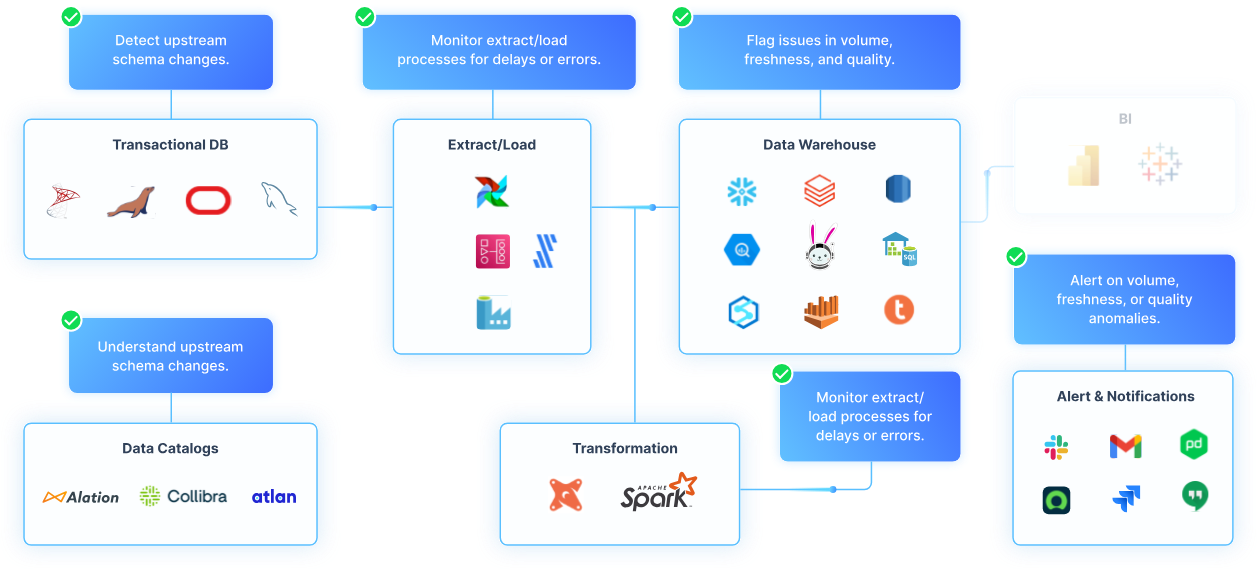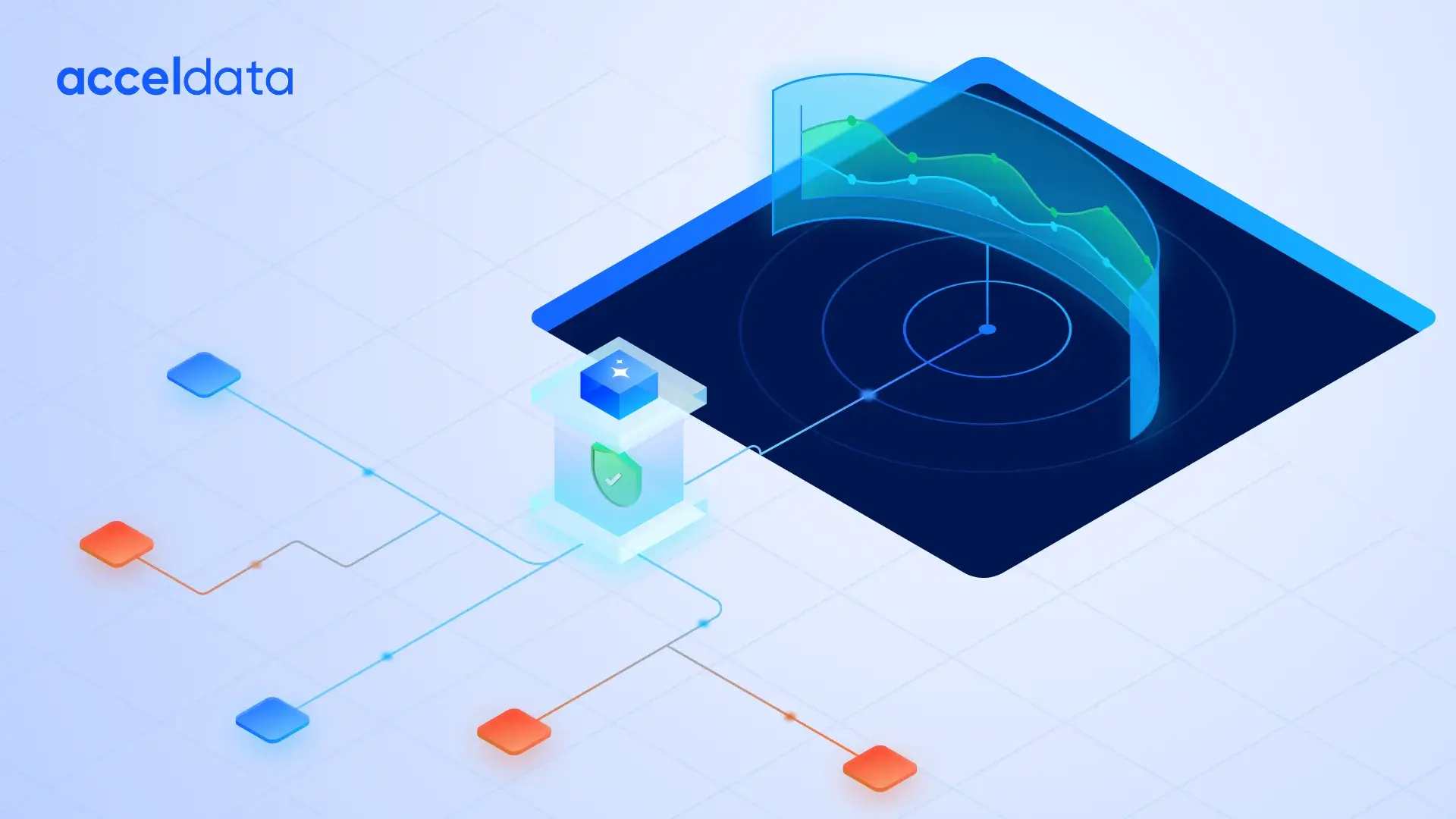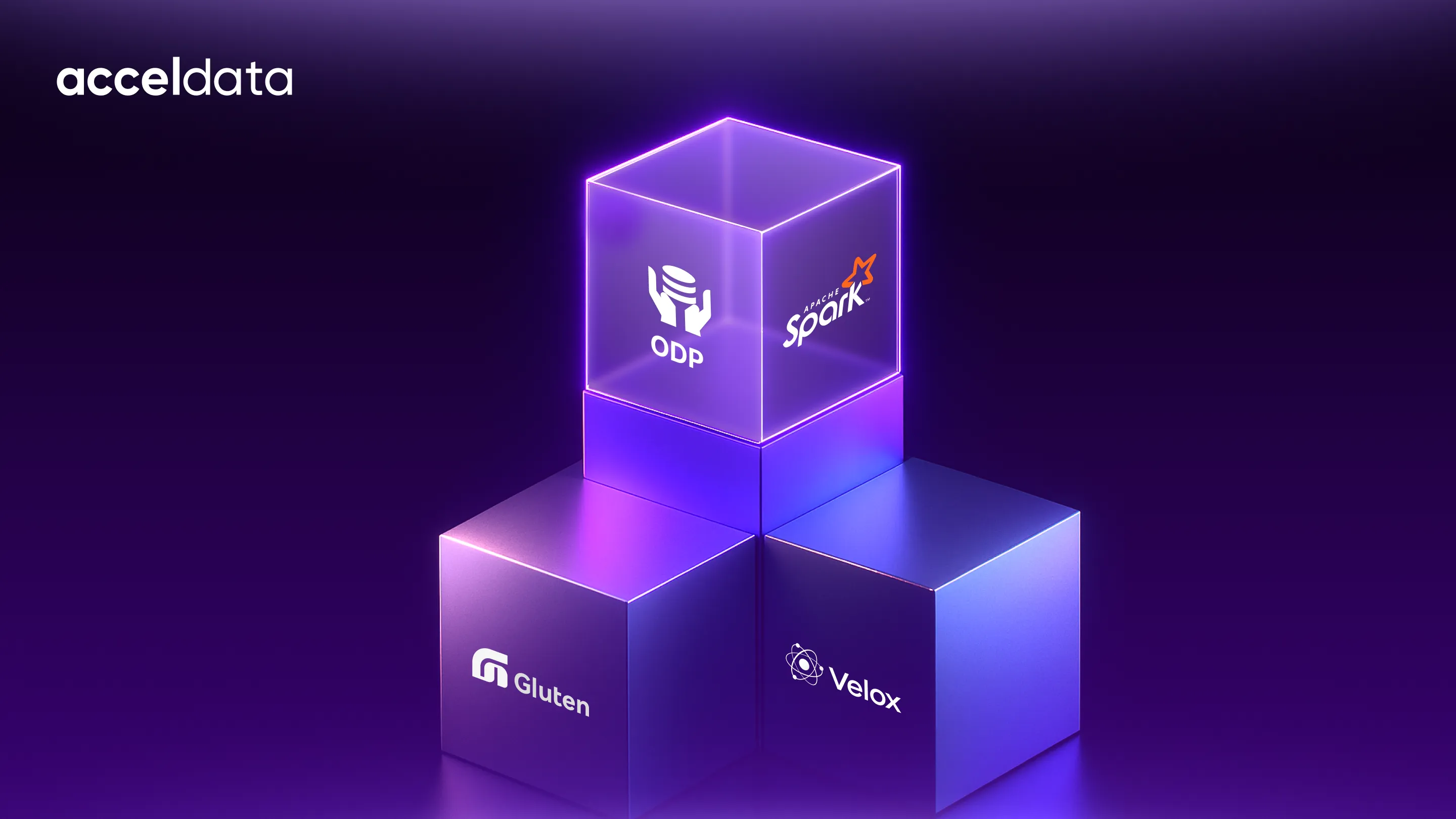In 2024, humans and machines generated an estimated 402 million terabytes of data daily, and this number is only expected to rise. Each transaction, interaction, and connected device adds to this surge, widening the governance gap that legacy methods can’t handle.
Fragmented systems, inconsistent policies, and tightening regulations turn the flood into compliance risks, inefficiencies, and lost business value.
An AI-powered data governance process bridges this gap by replacing static rules and manual oversight with automated, measurable controls that scale across the enterprise. With intelligence embedded throughout the data lifecycle, organizations achieve both efficiency and compliance while keeping data reliable and actionable.
In this article, we’ll explore how the AI-powered data governance framework works and why it’s becoming essential for modern enterprises.
What is an AI-Powered Data Governance Process?
At its core, an AI-powered data governance process enhances the governance lifecycle with automation and intelligence: discover → classify → monitor → enforce → audit → improve.
Unlike traditional governance tools, it actively classifies data, tracks lineage, enforces policies, scores risks, and generates audit-ready evidence in real time.
The key areas where AI makes a difference include:
- Automated classification of sensitive data such as PII, PHI, or PCI.
- Lineage mapping to visualize dependencies and impacts across systems.
- Policy enforcement that adapts dynamically to context.
- Risk-based scoring to prioritize reviews and remediation.
- Evidence automation to reduce audit preparation time.
Together, these capabilities allow enterprises to scale governance without relying on endless manual reviews.
Reference Framework (Operating Model)
Strong governance doesn’t happen in silos. It requires all aspects to work in sync to form a living framework. An effective AI data governance operating model brings together:
- People: Data owners, stewards, custodians, with clear RACI for decisions
- Policies and standards: Rules for access, retention, sensitive data (PII/PHI), and quality SLOs
- Processes: Structured workflows for change management, issue handling, and DPIA/ROPA requirements
- Technology: Active metadata catalogs, lineage tracking, data quality checks, AI-driven policy engines, and ITSM integrations
This model shifts governance from being a tool-centric exercise to a coordinated system of accountability, automation, and continuous improvement.
Best Practices for an AI-Powered Governance Process
An AI-powered governance process requires more than deploying smart tools. It comes down to building habits that ensure governance is both sustainable and trusted.
Follow these AI data governance best practices:
- Use active metadata and lineage for continuous, column-level impact analysis.
- Automate classification with ML/NLP to tag PII, PHI, or PCI without manual effort.
- Adopt policy as code for RBAC/ABAC, masking, retention, and tokenization with Git-based version control.
- Apply risk-based controls by scoring datasets to prioritize enforcement where business impact is highest.
- Keep humans in the loop for approvals in sensitive cases and maintain explainability logs.
- Close the loop on quality by detecting → deciding → acting → verifying in real time.
- Automate evidence with audit packs, immutable logs, and control tests ready for regulators.
By embedding these practices, organizations can shift governance from a reactive compliance exercise into a proactive framework that protects value, reduces risk, and builds long-term trust in enterprise data.
The AI Data Governance Lifecycle: A Playbook for Action
Best practices only work when they’re applied consistently. That’s where a structured lifecycle comes in, turning governance principles into repeatable, measurable action.
An AI-powered governance process typically follows this playbook:
- Discover and inventory: Connect data sources and auto-scan assets
- Classify and lab: Assign sensitivity, domains, and ownership
- Define controls: Set policies, thresholds, and SLOs
- Enforce and monitor: Apply real-time checks, alerts, and automated actions
- Remediate and review: Open tickets, apply runbooks, and trace with lineage
- Report and audit: Generate dashboards and evidence packs
- Improve: Use feedback learnings to refine policies and AI models
Through these steps, enterprises ensure governance is a living process, continuously adapting as data, risks, and regulations evolve.
Anchoring AI Governance to Trusted Frameworks
The governance lifecycle becomes even more powerful when it’s aligned with globally recognized frameworks. Rather than reinventing the wheel, AI-powered data governance can map directly to standards that regulators, auditors, and business leaders already trust.
These include:
- DAMA-DMBOK: Provides governance and data quality principles
- COBIT: Defines control objectives and IT governance best practices
- NIST Privacy/CSF: Guides risk and privacy management
- ISO 27001/27701: Establishes security and privacy controls for compliance
For example, automated classification maps to ISO A.8/A.9, monitoring links to COBIT DSS, and DPIA automation supports NIST/ISO 27701.
Anchoring your AI governance process to these frameworks ensures not only compliance today but also resilience against tomorrow’s regulatory shifts.
Tooling Checklist: Essentials for AI Governance in Practice
Aligning with frameworks is only effective if your technology stack can support it. That’s where the right tooling comes in. AI-powered governance platforms need a solid foundation of features to make policies actionable and sustainable.
At a minimum, look for:
- Catalog and active metadata graph: For complete asset discovery and dynamic context
- End-to-end lineage: From ELT processes to BI dashboards, ensuring full traceability
- Data quality and observability: Covering freshness, completeness, and anomaly detection
- AI policy engine: Combining rules, ML-driven checks, and automated enforcement
- Access governance: With just-in-time provisioning, periodic reviews, and automatic revocations
- Integrations: With systems such as Snowflake, Databricks, BigQuery, Redshift, dbt, Airflow, Okta, and ServiceNow
- Evidence and reporting: Audit-ready dashboards, control tests, and compliance packs
With these essentials in place, governance shifts from being a siloed process to becoming a native part of enterprise workflows, transparent, automated, and always audit-ready.
Implementation Roadmap: Building AI Governance in 90 Days
Organizations spend an estimated 10–30% of revenue managing data quality issues, highlighting the high cost of poor governance. A phased rollout of AI-powered data governance ensures adoption is smooth, measurable, and tied to business outcomes.
Here’s a practical 30-60-90 roadmap:
- Days 0–30: Establish visibility
Connect core data sources, baseline lineage, and classify sensitive data to gain a clear map of risk and ownership. - Days 31–60: Prove enforcement
Translate policies into automated rules, pilot them in high-impact domains, and trigger alerts and tickets to cut down manual oversight. - Days 61–90: Scale confidence
Expand enforcement across more domains, automate audit evidence, and deliver executive scorecards to demonstrate compliance and business value.
This structured rollout provides quick wins in the first month while steadily building a mature, sustainable governance model that scales across the enterprise.
Measuring Success: KPIs That Prove Business Value
A roadmap is only as powerful as the outcomes it produces. Once AI-powered data governance is live, it must deliver tangible business results.
Consider the case of a global data provider that dramatically improved operations with Acceldata, reducing data quality processing time from 22 days to just 7 hours while scaling checks across 500 billion+ rows.
This real-world example brings KPIs to life:
- Fewer policy violations and lower MTTR: Fast detection and response reduce incident volume and resolution time.
- More datasets meeting data quality SLOs: Reliable data becomes the rule, not the exception.
- Shorter access request cycles with greater least-privilege coverage: Balanced agility with security.
- Reduced audit prep hours plus higher control effectiveness: Streamlined compliance with demonstrable controls.
- More certified/owned assets and higher catalog search-to-use conversion: Improved trust and adoption of governed data.
These KPIs show how governance, powered by data observability and AI automation, becomes a strategic driver, not just a compliance checkbox.
The Acceldata Advantage: AI Governance for Enterprise Data
Acceldata's agentic data management (ADM) platform transforms the AI-powered data governance process by combining unified observability with active metadata that feeds directly into an AI policy engine. Unlike traditional rule-based systems, ADM employs autonomous agents equipped with real-time lineage and contextual reasoning to detect, diagnose, and resolve data issues across structured, unstructured, and streaming environments.

Key capabilities include:
- Lineage-aware auto-actions: Mask, quarantine, rollback, or open tickets automatically, with audit-ready evidence to support compliance and audit evidence automation with AI.
- AI-driven anomaly detection with human-in-the-loop validation: Detect issues across the AI data governance lifecycle while maintaining oversight and accuracy.
- Root cause analysis and remediation: Identify the source of data quality issues at the pipeline, table, file, or row level, enabling fast resolution and stronger AI in data quality governance.
- AI policy automation for data and governance: Automate enforcement of data policies, including RBAC/ABAC, retention, and masking, across all stages of data.
- Automated evidence packs: Streamline audits and reporting with immutable logs and control tests, ensuring compliance is measurable and repeatable.
By embedding AI across the data governance framework, Acceldata automates the governance process, strengthens compliance, and turns reactive monitoring into a business-enabling function. With Acceldata’s ADM platform, enterprises can turn data governance from a reactive necessity into a strategic advantage that drives trust, compliance, and measurable business value.
Turning AI-Powered Data Governance into a Strategic Advantage
The volume and complexity of enterprise data make traditional governance approaches inadequate. AI-powered data governance bridges this gap by automating discovery, classification, monitoring, enforcement, and auditing across all data assets. This ensures data is accurate, secure, and compliant while reducing manual effort.
Acceldata’s Agentic Data Management (ADM) enhances this process with AI-driven policy enforcement, lineage-aware auto-actions, anomaly detection, and automated evidence packs, providing real-time visibility and measurable compliance.
By following structured operating models, governance best practices, and phased rollouts, organizations can turn data governance from a reactive necessity into a strategic asset. The result is reduced risk, faster decision-making, and actionable, trustworthy data that drives business value.
Ready to operationalize AI-powered governance? See how Acceldata automates your data governance process end-to-end. Request a demo today.
FAQs about AI Data Governance
1. How does AI differ from rule-only governance?
AI-powered data governance processes go beyond static rules by using ML, lineage, and policy automation for real-time detection, enforcement, and remediation. This approach ensures continuous compliance and actionable insights across all data.
2. Can we keep human approvals for sensitive actions?
Yes, AI data governance best practices include human-in-the-loop validation to approve or override automated actions for critical or sensitive data. This maintains control while leveraging automation for efficiency.
3. How do we handle AI misclassification risk?
Active metadata for governance and lineage-aware monitoring helps identify misclassifications quickly. Feedback loops allow AI models to learn and reduce errors over time.
4. What’s required to integrate with our stack?
An AI-powered data governance framework works with existing data platforms via connectors and APIs, supporting catalogs, warehouses, ETL pipelines, BI tools, and ITSM systems. This ensures seamless enforcement, monitoring, and evidence collection.














.webp)
.webp)


